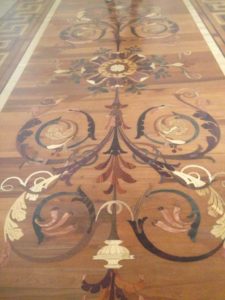St. Petersburg, founded in 1703 by Peter the Great after his war against Sweden gained him an outlet on the Baltic Sea, is called the Venice of the north because it is a city of canals (but also streets). Today it is a city of 5 million people (officially) but 12 (unofficially, including the suburbs). Surprisingly, in spite of its great beauty, the city is losing population because it is expensive and does not offer the job opportunities of cities such as Moscow. It is visited by more than 12 million tourists each year (already more than 20 million this year because of the FIFA World Cup).
We were lucky to have fairly warm weather and only scattered showers while we were here because St. Petersburg is as far north as Alaska and only gets an average of 30 days of sunshine a year.
St. Petersburg is a beautiful city, one designed by Christopher Wren, whom Peter the Great met in 1697 in London. It was built on swampy ground, so buildings could not be tall, and by decree not taller than the Winter Palace, (67 ft). Muscovites were skeptical of moving to the new city, but Peter the Great (henceforth PTG) decreed that they could choose St. Petersburg or Siberia, so the city grew quickly. PTG also decreed that stone could be used as a building material only in St. Petersburg (and nowhere else in Russia). The city is architectural very European. By turns, I felt like I was in Paris, London, and Venice.
St. Petersburg is built along the Neva River that empties into the Gulf of Finland.
St. Petersburg was renamed several times. In 1914 at the outbreak of WW I, it was renamed Petrograd, in 1924, after the death of Lenin, it was renamed Leningrad, and in 1991, citizens voted to rename it St. Petersburg. It was the cradle of the October, 1917 socialist revolution.
Our first stop was the Smolny Cathedral (1748-1769), a blue and white cathedral designed by the architect of all the royal buildings.
Next, in the middle of a downpour, we stopped at the Church of the Resurrection, renamed the Church on the Spilled Blood after Alexander II was assassinated here in 1881. Alexander had initiated a number of reforms, including freeing the serfs. The towers were being restored, so I didn’t get great pictures, but here’s one from the St. Petersburg guide that I bought.
The Hermitage Museum along Nevsky Prospekt, the main avenue of the city, is five buildings, including The Winter Palace, the Small, Hermitage, the old Hermitage, and the Hermitage Theater.
The Winter Palace was constructed on the Palace Square between 1754 and 1762 by Italian architect Francesco Bartolomeo Rastrelli (who designed all the royal palaces in the area). It was the main residence of the Russian rulers. It holds 3 million pieces of art. We had a tour that took us through all the major rooms in a little over an hour. Needless to say, it was overwhelming. Art by every major name. Huge malachite vases, inlaid floors.

Each room is designed to compliment the art.
There is a Greek room, with the largest collection of Greek vases in the world.
The Fontina River (a man-made canal built to feed fountains of the summer garden) once marked the boundaries of the city. The city has a mixture of modern architecture and traditional.
The Peter and Paul Fortress and Cathedral, built in 1703 on a small island, is the first building completed in St. Petersburg,
The interior is ornate.  It is the burial place of all the Russian rulers, from Peter the Great to the Romanovs.
It is the burial place of all the Russian rulers, from Peter the Great to the Romanovs.
St. Isaac’s Cathedral, with its huge golden dome, was built between 1818 and 1858. It is the largest cathedral in Russia and the fourth larges single dome in the world.
That night I went on an evening cruise of the canals, which was gorgeous.
St. Petersburg seen from the water is very reminiscent of Venice.

















